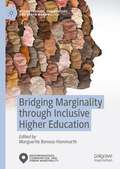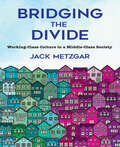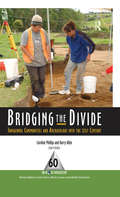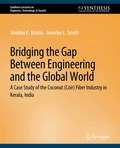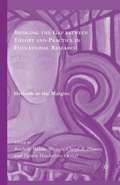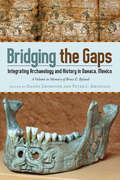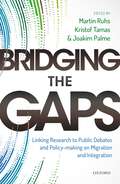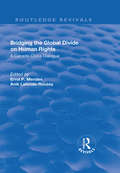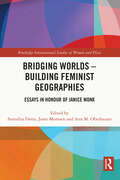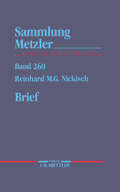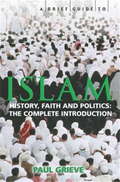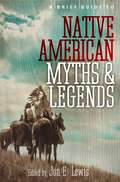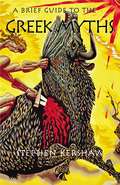- Table View
- List View
Bridging Marginality through Inclusive Higher Education (Neighborhoods, Communities, and Urban Marginality)
by Marguerite Bonous-HammarthThis book examines the changing influences of diversity in American higher education. The volume offers evidence and recommendations to positively shape inclusive learning and engagement of students, faculty, staff and community across the complex terrains of urban, suburban, and rural organizations within higher education today. Chapters highlight critical collaborations across student affairs and academic affairs, and delve into milestones addressing access, retention, engagement, and thriving within distinctive institutional types (e.g., research, liberal arts, community colleges, Minority Serving Institutions). Authors also explore the nuanced changes occurring against the contemporary backdrop of COVID-19 experiences – including the rise of anti-Asian racism, the salience of implicit biases, and the disparate access to and impacts of health services. Essential chapters refocus our consideration about the trajectories of historically underrepresented groups and their peers (including, African Americans, Hispanic/Latino, Indigenous people, individuals with disabilities and those identifying as LGBTQ+, undocumented students, and women) in American higher education.
Bridging the Divide: Working-Class Culture in a Middle-Class Society
by Jack MetzgarIn Bridging the Divide, Jack Metzgar attempts to determine the differences between working-class and middle-class cultures in the United States. Drawing on a wide range of multidisciplinary sources, Metzgar writes as a now middle-class professional with a working-class upbringing, explaining the various ways the two cultures conflict and complement each other, illustrated by his own lived experiences.Set in a historical framework that reflects on how both class cultures developed, adapted, and survived through decades of historical circumstances, Metzgar challenges professional middle-class views of both the working-class and themselves. In the end, he argues for the creation of a cross-class coalition of what he calls "standard-issue professionals" with both hard-living and settled-living working people and outlines some policies that could help promote such a unification if the two groups had a better understanding of their differences and how to use those differences to their advantage. Bridging the Divide mixes personal stories and theoretical concepts to give us a compelling look inside the current complex position of the working-class in American culture and a view of what it could be in the future.
Bridging the Divide: Indigenous Communities and Archaeology into the 21st Century
by Caroline Phillips Harry AllenThe collected essays in this volume address contemporary issues regarding the relationship between Indigenous groups and archaeologists, including the challenges of dialogue, colonialism, the difficulties of working within legislative and institutional frameworks, and NAGPRA and similar legislation. The disciplines of archaeology and cultural heritage management are international in scope and many countries continue to experience the impact of colonialism. In response to these common experiences, both archaeology and indigenous political movements involve international networks through which information quickly moves around the globe. This volume reflects these dynamic dialectics between the past and the present and between the international and the local, demonstrating that archaeology is a historical science always linked to contemporary cultural concerns.
Bridging the Divide: Indigenous Communities and Archaeology into the 21st Century (One World Archaeology Ser. #60)
by Caroline Phillips Harry AllenThe collected essays in this volume address contemporary issues regarding the relationship between Indigenous groups and archaeologists, including the challenges of dialogue, colonialism, the difficulties of working within legislative and institutional frameworks, and NAGPRA and similar legislation. The disciplines of archaeology and cultural heritage management are international in scope and many countries continue to experience the impact of colonialism. In response to these common experiences, both archaeology and indigenous political movements involve international networks through which information quickly moves around the globe. This volume reflects these dynamic dialectics between the past and the present and between the international and the local, demonstrating that archaeology is a historical science always linked to contemporary cultural concerns.
Bridging the Gap Between Engineering and the Global World: A Case Study of the Coconut (Coir) Fiber Industry in Kerala, India (Synthesis Lectures on Engineers, Technology, & Society)
by Shobha K. Bhatia Jennifer L. SmithOver the last two decades, globalization has had a profound impact on how we view the world and its sustainability. One group of professionals that lies at the heart of sustainability is the engineers. Engineers are trained problem solvers, required to implement technical solutions and are at the forefront of the development of new technologies. Although engineers play a critical role in sustainability, traditional engineering programs typically only focus on the technocentric and ecocentric dimensions of sustainability, providing little training on the sociocentric dimension. With more and more interest in sustainability, it is becoming increasingly important to also provide engineers with an awareness of sociocentric issues and the necessary skills to address them. The aim of this book is to provide engineering educators with a real-life case study that can be brought into existing courses to help bridge the gap between engineering and the global world. The case study focuses on how our engineering study of different natural plant fibers for soil erosion control led us to small villages in Kerala, India, where marginalized women workers often stand waste deep in water several hours a day, clean and beat coconuts by hand, and separate and spin coconut (coir) fibers into yarn by hand, for very low wages. The case study provides insight into the three dimensions of sustainability (technocentric, ecocentric, and sociocentric) and how they come together in a typical engineering problem. Table of Contents: Reinforcing the Classroom / Natural Plant Fibers for Engineering Applications: Technocentric and Ecocentric Dimensions of Sustainability / The Coir Fiber Industry in Kerala, India: Sociocentric Dimension of Sustainability / Case Study / Conclusion / Bibliography
Bridging the Gap between Theory and Practice in Educational Research: Methods at the Margins
by Rachelle Winkle-Wagner Cheryl A. HunterThis book provides new ways of thinking about educational processes, using quantitative and qualitative methodologies. Ultimately, it aims at expanding knowledge itself - altering the centre by allowing the margins to inform it - allowing it to be extended to include those ways of knowing that have historically been unexplored or ignored.
Bridging the Gaps: Integrating Archaeology and History in Oaxaca, Mexico; A Volume in Memory of Bruce E. Byland
by Peter Kroefges Danny ZboroverBridging the Gaps: Integrating Archaeology and History in Oaxaca, Mexico does just that: it bridges the gap between archaeology and history of the Precolumbian, Colonial, and Republican eras of the state of Oaxaca, Mexico, a cultural area encompassing several of the longest-enduring literate societies in the world. Fourteen case studies from an interdisciplinary group of archaeologists, anthropologists, ethnohistorians, and art historians consciously compare and contrast changes and continuities in material culture before and after the Spanish conquest, in Prehispanic and Colonial documents, and in oral traditions rooted in the present but reflecting upon the deep past. Contributors consider both indigenous and European perspectives while exposing and addressing the difficulties that arise from the application of this conjunctive approach. Inspired by the late Dr. Bruce E. Byland’s work in the Mixteca, which exemplified the union of archaeological and historical evidence and inspired new generations of scholars, Bridging the Gaps promotes the practice of integrative studies to explore the complex intersections between social organization and political alliances, religion and sacred landscape, ethnic identity and mobility, colonialism and resistance, and territoriality and economic resources.
Bridging the Gaps: Linking Research to Public Debates and Policy Making on Migration and Integration
by Martin Ruhs Kristof Tamas Joakim PalmeWhat is the use of research in public debates and policy-making on immigration and integration? Why are there such large gaps between migration debates and migration realities, and how can they be reduced? Bridging the Gaps: Linking Research to Public Debates and Policy Making on Migration and Integration provides a unique set of testimonies and analyses of these questions by researchers and policy experts who have been deeply involved in attempts to link social science research to public policies. Bridging the Gaps argues that we must go beyond the prevailing focus on the research-policy nexus by considering how the media, public opinion, and other dimensions of public debates can interact with research and policy-processes. The chapters provide theoretical analyses and personal assessments of the successes and failures of past efforts to link research to public debates and policy-making on migration and integration in six different countries - Germany, the Netherlands, Norway, Sweden, the United Kingdom, and the United States - as well as in European and global governance debates. Contrary to common public perceptions and political demands, Bridging the Gaps argues that all actors contributing to research, public debates, and policy-making should recognize that migration, integration, and related decision-making are highly complex issues, and that there are no quick fixes to what are often enduring policy dilemmas. When the different actors understand and appreciate each other's primary aims and constraints, such common understandings can pave the way for improved policy-making processes and better public policies that deal more effectively with the real challenges of migration and integration. This is an open access title available under the terms of a CC BY-NC-ND 4.0 International licence. It is free to read at Oxford Scholarship Online and offered as a free PDF download from OUP and selected open access locations.
Bridging the Gaps: Linking Research to Public Debates and Policy Making on Migration and Integration
What is the use of research in public debates and policy-making on immigration and integration? Why are there such large gaps between migration debates and migration realities, and how can they be reduced? Bridging the Gaps: Linking Research to Public Debates and Policy Making on Migration and Integration provides a unique set of testimonies and analyses of these questions by researchers and policy experts who have been deeply involved in attempts to link social science research to public policies. Bridging the Gaps argues that we must go beyond the prevailing focus on the research-policy nexus by considering how the media, public opinion, and other dimensions of public debates can interact with research and policy-processes. The chapters provide theoretical analyses and personal assessments of the successes and failures of past efforts to link research to public debates and policy-making on migration and integration in six different countries - Germany, the Netherlands, Norway, Sweden, the United Kingdom, and the United States - as well as in European and global governance debates. Contrary to common public perceptions and political demands, Bridging the Gaps argues that all actors contributing to research, public debates, and policy-making should recognize that migration, integration, and related decision-making are highly complex issues, and that there are no quick fixes to what are often enduring policy dilemmas. When the different actors understand and appreciate each other's primary aims and constraints, such common understandings can pave the way for improved policy-making processes and better public policies that deal more effectively with the real challenges of migration and integration. This is an open access title available under the terms of a CC BY-NC-ND 4.0 International licence. It is free to read at Oxford Scholarship Online and offered as a free PDF download from OUP and selected open access locations.
Bridging the Global Divide on Human Rights: A Canada-China Dialogue
by Errol P. Mendes Anik Lalonde-RoussyThis title was first published in 2003. In this collection of essays that explores Western and Chinese perspectives on human rights, leading Canadian and Chinese scholars bridge the global divide on some of the key aspects of human rights. Issues covered include the role of civil society in human rights protection, the imperative of the rule of law in the protection of human rights, freedom of expression and its relation to social, economic and cultural development and corruption in the public and private sectors. The volume also focuses on the domestic implementation of human rights treaties and offers gender perspectives on implementing social and economic rights in an era of globalization. The independent Chinese and Canadian scholars present a new vision of global pluralism in the area of human rights protection in a modernizing China and in the rest of the world.
Bridging the Global Divide on Human Rights: A Canada-China Dialogue (Routledge Revivals Ser.)
by Errol P. Mendes Anik Lalonde-RoussyThis title was first published in 2003. In this collection of essays that explores Western and Chinese perspectives on human rights, leading Canadian and Chinese scholars bridge the global divide on some of the key aspects of human rights. Issues covered include the role of civil society in human rights protection, the imperative of the rule of law in the protection of human rights, freedom of expression and its relation to social, economic and cultural development and corruption in the public and private sectors. The volume also focuses on the domestic implementation of human rights treaties and offers gender perspectives on implementing social and economic rights in an era of globalization. The independent Chinese and Canadian scholars present a new vision of global pluralism in the area of human rights protection in a modernizing China and in the rest of the world.
Bridging Worlds - Building Feminist Geographies: Essays in Honour of Janice Monk (Routledge International Studies of Women and Place)
by Anindita Datta Janet Momsen Ann M. OberhauserThis book marks the 30th anniversary of the IGU Commission on Gender and Geography, honouring the contributions of Janice Monk in establishing the field of feminist geography. The collection is published as part of the series International Studies of Women and Place that Janice Monk co-edited with Janet Momsen for over 30 years. The chapters, from over 45 leading international scholars, encompass key areas Monk has contributed to within feminist geography. The collaborative nature of this project reflects the networks and themes Monk nurtured throughout her long and impactful career. The book provides critical insights to wide-ranging topics that include the development of feminist geography in different global contexts, gendered geographies of work and everyday life, and gender and environmental concerns. Diverse voices and perspectives in this book will serve as invaluable resources for scholars interested in gender and feminist geographies, the history of the IGU Commission on Gender and Geography, career trajectories of women geographers in different parts of the world, gendered geographies of the life course, as well as feminist analyses of environmental issues. The book will be useful to students, educators, and activists in gender studies, development studies, and human geography.
Bridging Worlds - Building Feminist Geographies: Essays in Honour of Janice Monk (Routledge International Studies of Women and Place)
by Anindita Datta Janet Momsen Ann M. OberhauserThis book marks the 30th anniversary of the IGU Commission on Gender and Geography, honouring the contributions of Janice Monk in establishing the field of feminist geography. The collection is published as part of the series International Studies of Women and Place that Janice Monk co-edited with Janet Momsen for over 30 years. The chapters, from over 45 leading international scholars, encompass key areas Monk has contributed to within feminist geography. The collaborative nature of this project reflects the networks and themes Monk nurtured throughout her long and impactful career. The book provides critical insights to wide-ranging topics that include the development of feminist geography in different global contexts, gendered geographies of work and everyday life, and gender and environmental concerns. Diverse voices and perspectives in this book will serve as invaluable resources for scholars interested in gender and feminist geographies, the history of the IGU Commission on Gender and Geography, career trajectories of women geographers in different parts of the world, gendered geographies of the life course, as well as feminist analyses of environmental issues. The book will be useful to students, educators, and activists in gender studies, development studies, and human geography.
The Bridleway: How Horses Shaped the British Landscape
by Tiffany Francis-BakerTiffany Francis-Baker explores how the relationship between humans and horses has shaped the British landscape, how horses have captured our wild imaginations, and how this connection has evolved and become part of our nation's ecosystems. Many of us enjoy walking on a bridleway. These ancient networks are familiar to walkers and riders and crisscross the British countryside, but we rarely stop to think about how these old routes came to be. In The Bridleway, Tiffany Francis-Baker examines our relationship with horses and ponders how they have become part of our nation's ecosystems. From atop her horse, Tiffany discovers how horses are woven into the fabric of British culture, from street and pub names to trading routes and coaching inns. As she investigates how horses have shaped British landscapes, she offers a glimpse into the intriguing history of the bridleway. Along the way, Tiffany visits a horse fair and learns about Traveller communities. She explores the role of equestrian sport and inclusivity, sees rewilding in action on the Knepp Estate in Sussex and undertakes detective work to uncover ancient bridleways lost to time and meet the closest living ancestors of the truly wild horse. Part-domesticated and part-fiercely independent, horses can teach us a lot about our landscape and help us understand nature and our place within it. Except for the dogs and cats we choose to share our homes with, we have allowed horses far deeper into our society than any other animal. And as Tiffany investigates why horses have captured Britons' attention, she reveals how deeply rooted they have been in our culture for thousands of years.
The Bridleway: How Horses Shaped the British Landscape
by Tiffany Francis-BakerTiffany Francis-Baker explores how the relationship between humans and horses has shaped the British landscape, how horses have captured our wild imaginations, and how this connection has evolved and become part of our nation's ecosystems. Many of us enjoy walking on a bridleway. These ancient networks are familiar to walkers and riders and crisscross the British countryside, but we rarely stop to think about how these old routes came to be. In The Bridleway, Tiffany Francis-Baker examines our relationship with horses and ponders how they have become part of our nation's ecosystems. From atop her horse, Tiffany discovers how horses are woven into the fabric of British culture, from street and pub names to trading routes and coaching inns. As she investigates how horses have shaped British landscapes, she offers a glimpse into the intriguing history of the bridleway. Along the way, Tiffany visits a horse fair and learns about Traveller communities. She explores the role of equestrian sport and inclusivity, sees rewilding in action on the Knepp Estate in Sussex and undertakes detective work to uncover ancient bridleways lost to time and meet the closest living ancestors of the truly wild horse. Part-domesticated and part-fiercely independent, horses can teach us a lot about our landscape and help us understand nature and our place within it. Except for the dogs and cats we choose to share our homes with, we have allowed horses far deeper into our society than any other animal. And as Tiffany investigates why horses have captured Britons' attention, she reveals how deeply rooted they have been in our culture for thousands of years.
Brief (Sammlung Metzler)
by Reinhard M. NickischDie Briefforschung im Blickpunkt. Der Brief spielt in der Kultur und der Literatur eine prägende Rolle. Der folgende Band beschreibt Wesen, Funktion, Verwendung, die geschichtliche Entwicklung des Briefes vom Mittelalter bis heute, gibt Einblicke in die Rezeptions- und Wirkungsgeschichte der Briefliteratur und zeigt die Probleme und Aufgaben der Briefforschung.
Brief Behavioral Therapy for Anxiety and Depression in Youth: Workbook (Programs That Work)
by V. Robin Weersing Araceli Gonzalez Michelle RozenmanAnxiety and depression are the most common psychological challenges for children and adolescents, with nearly 1 in 5 youths suffering from a significant episode before adulthood. Without intervention, these issues can have lasting impact, with links to persistent struggles with mood, poorer physical health, school drop-out, and substance abuse. Brief Behavioral Therapy for Anxiety and Depression in Youth: Workbook details a problem-focused, short-term behavioral intervention designed to promote rapid change in youth symptoms in 8 to 12 sessions. BBT targets youths' avoidance of stress and negative feelings and promotes active engagement with the important activities of youths' lives - school, family, friendships. In the first phase of treatment, youth are taught relaxation and problem-solving strategies to cope with stress. In the second phase, youths develop and practice a personalized action plan to engage in challenging life tasks and activities. Throughout, the program allows for flexibility to accommodate family cultural values, youth age and maturity level, and youths' personalized symptom profile. Designed to work alongside the corresponding Therapist Guide, Brief Behavioral Therapy for Anxiety and Depression in Youth promotes thoughtful collaboration between therapists, parents, and children, helping young people to learn that they can endure situations that are scary, unpleasant, or overwhelming and reach their goals in life.
Brief Behavioral Therapy for Anxiety and Depression in Youth: Therapist Guide (Programs That Work)
by V. Robin Weersing Araceli Gonzalez Michelle RozenmanAnxiety and depression are the most prevalent mental health problems for children and adolescents, with nearly 1 in 5 youths suffering from a significant episode before adulthood. Without intervention, these emotional issues can have lasting impacts on youths' development, with links to persistent struggles with mood, poorer physical health, school drop-out, and an increased chance of substance abuse across the lifespan. Brief Behavioral Therapy for Anxiety and Depression in Youth: Therapist Guide is based on an innovative program of research suggesting that the complex youth problems of anxiety and depression can be efficiently treated with a core set of behavioral tools. The treatment is a problem-focused, short-term intervention that combines exposure and behavioral activation to promote rapid change in youth symptoms in 8 to 12 sessions. In the manner of third-wave behavioral approaches, the program targets youths' avoidance of stress and negative feelings and promotes active engagement with the important activities of youth's lives - school, family, friendships. The program has proven to be both clinically effective and cost-effective in primary care and has been delivered successfully in a variety of other clinical practice settings. Further, BBT has shown positive effects with both children and adolescents and with diverse families and youths. Designed to work alongside a participant Workbook, BBT can be implemented by care providers at varying levels of training and discipline. The BBT treatment allows flexibility to accommodate youth's cultural values, family structure, developmental level, and specific symptoms and areas of impairment. With thoughtful collaboration between therapists, parents and their children, Brief Behavioral Therapy for Anxiety and Depression in Youth will help young people learn that they can endure situations that are scary, unpleasant, or overwhelming and reach their goals in life.
Brief Behavioral Therapy for Anxiety and Depression in Youth: Therapist Guide (Programs That Work)
by V. Robin Weersing Araceli Gonzalez Michelle RozenmanAnxiety and depression are the most prevalent mental health problems for children and adolescents, with nearly 1 in 5 youths suffering from a significant episode before adulthood. Without intervention, these emotional issues can have lasting impacts on youths' development, with links to persistent struggles with mood, poorer physical health, school drop-out, and an increased chance of substance abuse across the lifespan. Brief Behavioral Therapy for Anxiety and Depression in Youth: Therapist Guide is based on an innovative program of research suggesting that the complex youth problems of anxiety and depression can be efficiently treated with a core set of behavioral tools. The treatment is a problem-focused, short-term intervention that combines exposure and behavioral activation to promote rapid change in youth symptoms in 8 to 12 sessions. In the manner of third-wave behavioral approaches, the program targets youths' avoidance of stress and negative feelings and promotes active engagement with the important activities of youth's lives - school, family, friendships. The program has proven to be both clinically effective and cost-effective in primary care and has been delivered successfully in a variety of other clinical practice settings. Further, BBT has shown positive effects with both children and adolescents and with diverse families and youths. Designed to work alongside a participant Workbook, BBT can be implemented by care providers at varying levels of training and discipline. The BBT treatment allows flexibility to accommodate youth's cultural values, family structure, developmental level, and specific symptoms and areas of impairment. With thoughtful collaboration between therapists, parents and their children, Brief Behavioral Therapy for Anxiety and Depression in Youth will help young people learn that they can endure situations that are scary, unpleasant, or overwhelming and reach their goals in life.
Brief Behavioral Therapy for Anxiety and Depression in Youth: Workbook (Programs That Work)
by V. Robin Weersing Araceli Gonzalez Michelle RozenmanAnxiety and depression are the most common psychological challenges for children and adolescents, with nearly 1 in 5 youths suffering from a significant episode before adulthood. Without intervention, these issues can have lasting impact, with links to persistent struggles with mood, poorer physical health, school drop-out, and substance abuse. Brief Behavioral Therapy for Anxiety and Depression in Youth: Workbook details a problem-focused, short-term behavioral intervention designed to promote rapid change in youth symptoms in 8 to 12 sessions. BBT targets youths' avoidance of stress and negative feelings and promotes active engagement with the important activities of youths' lives - school, family, friendships. In the first phase of treatment, youth are taught relaxation and problem-solving strategies to cope with stress. In the second phase, youths develop and practice a personalized action plan to engage in challenging life tasks and activities. Throughout, the program allows for flexibility to accommodate family cultural values, youth age and maturity level, and youths' personalized symptom profile. Designed to work alongside the corresponding Therapist Guide, Brief Behavioral Therapy for Anxiety and Depression in Youth promotes thoughtful collaboration between therapists, parents, and children, helping young people to learn that they can endure situations that are scary, unpleasant, or overwhelming and reach their goals in life.
A Brief Guide to Celtic Myths and Legends (Brief Histories)
by Martyn WhittockA very readable guide which fills the gap between academic analysis and less critical retellings of the myths and legends. Marytn Whittock provides an accessible overview while also assessing the current state of research regarding the origins and significance of the myths. Since all records of the myths first occur in the early medieval period, the focus is on the survival of pre-Christian mythology and the interactions of the early Christian writers with these myths. A wide-ranging and enthralling introduction to Celtic mythology, from the Irish gods before gods, the Fomorians, to the children of Llyr, the sea deity; from the hunter-warrior Fionn mac Cumhaill, whose exploits are chronicled in the Fenian Cycle, to Cú Chulainn, the Hound of Ulster; and from the Welsh heroes of the Mabinogion to Arthur, King of Britain, though the mythical, Welsh version who predates the medieval legends.
A Brief Guide to Islam: History, Faith and Politics: The Complete Introduction (Brief Histories)
by Paul GrieveExploring the beliefs, history and politics of the ordinary people of Muslim countries, Grieve cuts through the complexities as he examines all aspects of Islam. He also addresses the big issues: can Islam support true democracy? Is true democracy what the West really wants for Muslim countries or are we merely seeking a cover of legitimacy for a policy of 'might is right'?Paul Grieve is an unbeliever - he is not a born-again Muslim, a proselytizer or a frustrated desert romantic. His aim is to inform. The result is an accessible but never simplistic guide that challengesstereotypical views, from women and banking to war and Malcolm X. Complete with advice for visitors to Muslim countries, and with carefully chosen primary sources, maps and illustrations, this is the ideal summary for the reader looking for an unbiased overview of the religious and political world issues that have become part of our everyday lives.
A Brief Guide to Native American Myths and Legends: With a new introduction and commentary by Jon E. Lewis (Brief Histories)
by Lewis SpenceIn this brilliant reworking of Lewis Spence's seminal Myths and Legends of the North American Indians, Jon E. Lewis puts the work in context with an extensive new introductory essay and additional commentary throughout the book on the history of Native Americans, their language and lifestyle, culture and religion/mythology. He includes examples of myths from tribes omitted by Spence, a guide to tribes and their myths by region, a basic Lakota (Sioux) glossary, guides to key pronunciations and a bibliography.
A Brief Guide to the Greek Myths (Brief Histories)
by Dr Stephen P. KershawThe book leads the reader through these vibrant stories, from the origins of the gods through to the homecomings of the Trojan heroes. All the familiar narratives are here, along with some less familiar characters and motifs. In addition to the tales, the book explains key issues arising from the narratives, and discusses the myths and their wider relevance.This long-overdue book crystallises three key areas of interest: the nature of the tales; the stories themselves; and how they have and might be interpreted. For the first time, it brings together aspects of Greek mythology only usually available in disparate forms - namely children's books and academic works. There will be much here that is interesting, surprising, and strange as well as familiar. Experts and non-experts, adults, students and schoolchildren alike will gain entertainment and insight from this fascinating and important volume.
A Brief History of Archaeology: Classical Times to the Twenty-First Century
by Nadia Durrani Brian M. FaganA Brief History of Archaeology details early digs and covers the development of archaeology as a multidisciplinary science, the modernization of meticulous excavation methods during the twentieth century, and the important discoveries that led to new ideas about the evolution of human societies. Spanning more than two thousand years of history, this short account of the discipline of archaeology tells of spectacular discoveries and the colorful lives of the archaeologists who made them, as well as of changing theories and current debates in the field. Early research at Stonehenge in Britain, burial mound excavations, and the exploration of Herculaneum and Pompeii culminate in the nineteenth-century debates over human antiquity and the theory of evolution. The book then moves on to the discovery of the world’s pre-industrial civilizations in Egypt, Mesopotamia, and Central America; the excavations at Troy and Mycenae; the Royal Burials at Ur, Iraq; and the dramatic finding of the pharaoh Tutankhamun in 1922. The book concludes by considering recent sensational discoveries and exploring the debates over processual and post-processual theory that have intrigued archaeologists in the early twenty-first century. The third edition updates this respected introduction to one of the science’s most fascinating disciplines. A Brief History of Archaeology is a vivid narrative that will engage readers who are new to the discipline, drawing on the authors’ extensive experience in the field and classroom.
